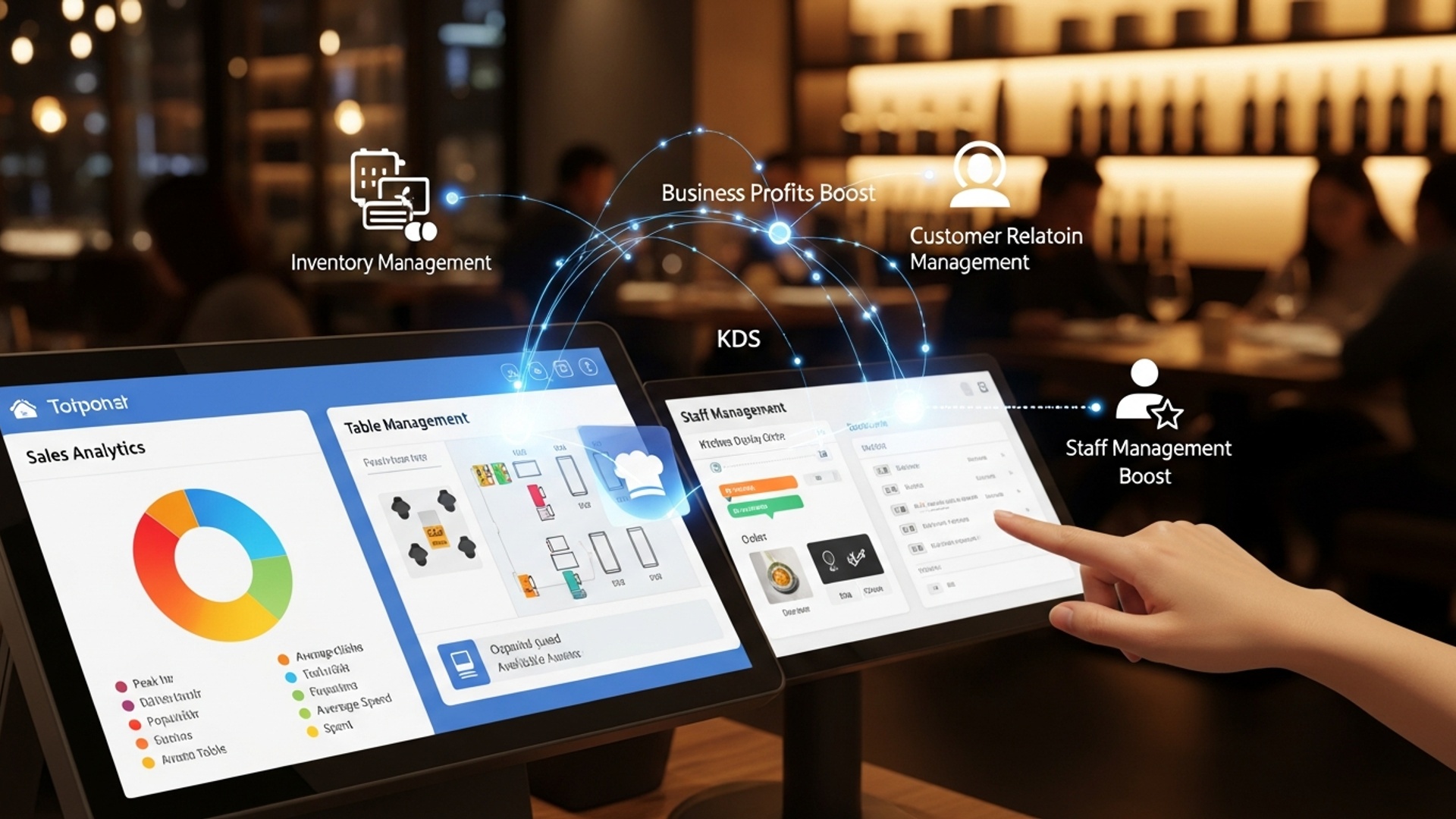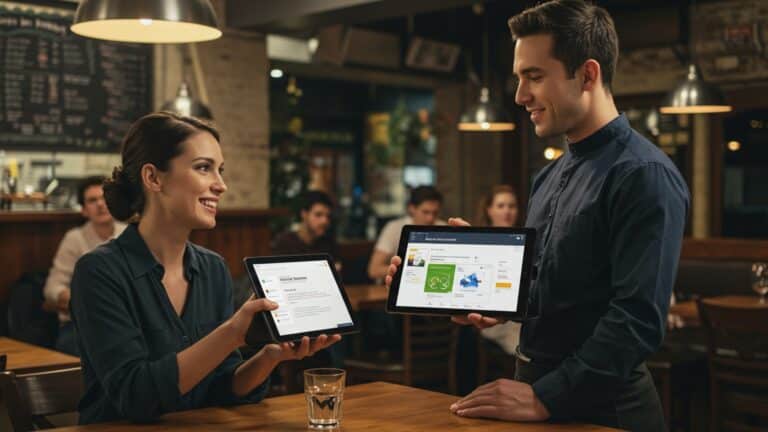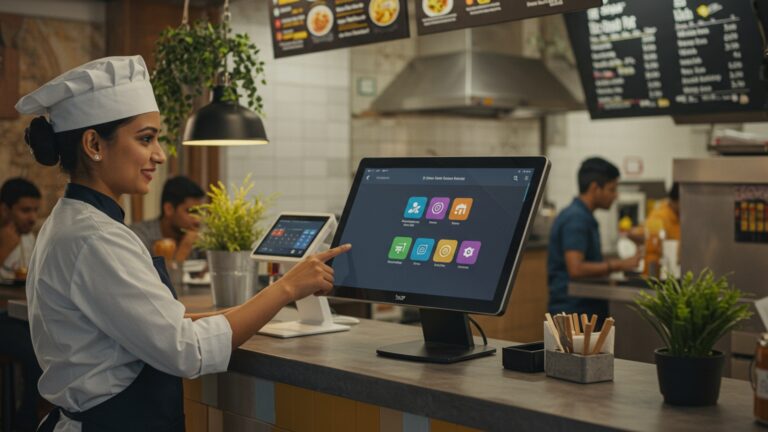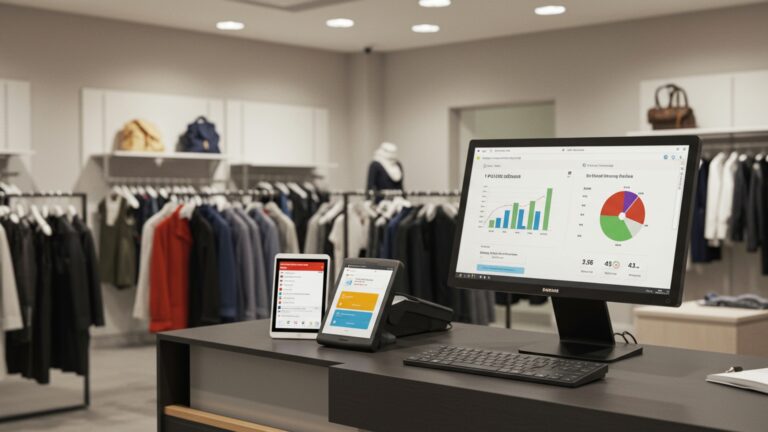Learn 7 Smart Restaurant POS Features to Boost Your Business Profits
In today’s fiercely competitive culinary landscape, where razor-thin margins and evolving customer expectations, from contactless ordering to hyper-personalized experiences, challenge traditional operations, merely processing transactions is no longer enough. Modern Restaurant POS software has transcended its basic function, transforming into an indispensable strategic tool for growth. Forward-thinking establishments now leverage advanced features like AI-driven sales analytics to dynamically optimize menu pricing, real-time inventory management to minimize costly waste. integrated online platforms to seamlessly capture broader digital revenue streams. Embracing these smart capabilities directly translates into streamlined workflows, enhanced customer loyalty through data-driven insights. ultimately, significantly boosted profit margins.

Understanding the Core Value of Restaurant POS Software
In today’s competitive culinary landscape, simply serving great food is often not enough to guarantee sustained success. Restaurants operate on thin margins. every operational inefficiency can directly impact profitability. This is where modern Restaurant POS software steps in, transforming from a simple transaction processor into a strategic business intelligence tool. A Point of Sale (POS) system, at its most basic, is where your customers make payments for goods or services. But, advanced Restaurant POS software goes far beyond this, integrating various aspects of restaurant operations into a single, cohesive platform. It’s the central nervous system of your establishment, designed to streamline processes, enhance customer experiences, and, critically, boost your bottom line.
Imagine a system that not only handles orders and payments but also tracks inventory, manages staff, analyzes sales trends. even facilitates online orders. That’s the power of a smart Restaurant POS software solution. By automating mundane tasks and providing actionable insights, it frees up your team to focus on what truly matters: delivering exceptional food and service. For restaurateurs, understanding and leveraging these advanced features is no longer optional; it’s a necessity for thriving in the modern market.
1. Integrated Inventory Management: Mastering Cost Control
One of the largest drains on restaurant profits is often inefficient inventory management, leading to food waste, theft. inaccurate ordering. Smart Restaurant POS software with integrated inventory management capabilities directly addresses this challenge, offering granular control over your ingredients and supplies.
- Definition: This feature allows restaurants to track every ingredient, from raw materials to finished dishes, in real-time. When an item is sold through the POS, the system automatically deducts the corresponding ingredients from your inventory counts.
- How it Boosts Profits:
- Reduces Waste: By knowing exactly what you have and what’s selling, you can optimize ordering, minimizing spoilage and overstocking.
- Controls Food Costs: Real-time tracking helps identify discrepancies, preventing theft and ensuring accurate portioning. It allows for precise calculation of plate costs.
- Automates Ordering: Set reorder points. the system can automatically generate purchase orders when stock levels are low, preventing stockouts of popular items.
- Identifies High-Cost Items: Detailed reports highlight ingredients that are expensive or frequently wasted, allowing menu adjustments or supplier negotiations.
- Real-world Application: Consider a bustling Italian restaurant. Before implementing a POS with integrated inventory, the chef might manually count pasta, tomatoes. cheeses weekly, leading to inconsistencies. With the new Restaurant POS software, every pasta dish sold automatically decrements the stock of pasta, sauce. cheese. At the end of the week, a report shows that a specific type of imported cheese is consistently going bad before being used up. The owner can then adjust their order quantity, switch to a smaller supplier, or even re-evaluate menu items that use less of that cheese, saving hundreds of dollars monthly.
2. Advanced Reporting and Analytics: Unlocking Data-Driven Decisions
The saying “knowledge is power” holds especially true in the restaurant industry. Modern Restaurant POS software excels at collecting vast amounts of data. its true power lies in its ability to transform this raw data into actionable insights through sophisticated reporting and analytics features.
- Definition: This feature compiles sales, labor, inventory. customer data into comprehensive reports, often with customizable dashboards and visual representations, allowing owners to identify trends, measure performance. make informed business decisions.
- How it Boosts Profits:
- Optimizes Menu: Pinpoint best-selling dishes, slow-moving items. high-profit vs. low-profit dishes. This enables menu engineering to emphasize profitable items and remove unpopular ones.
- Forecasts Sales: assess historical sales data to predict peak hours, busy days. seasonal trends, leading to better staffing and inventory planning.
- Evaluates Staff Performance: Track individual server sales, average check size. tip percentages to identify top performers and areas needing training.
- Identifies Bottlenecks: Reports can highlight slow service times, unpopular promotions, or operational inefficiencies that need addressing.
- Real-world Application: A cafe owner uses their Restaurant POS software to pull a monthly sales report. They notice that while their specialty lattes are popular, their profit margin is surprisingly low due to ingredient costs. Conversely, their seasonal fruit tarts, which they considered a niche item, have a high profit margin and consistent sales. Armed with this data, they decide to slightly increase the price of the lattes and prominently feature the fruit tarts in their display and marketing, leading to a significant bump in overall profit without alienating customers.
3. Online Ordering and Delivery Integration: Expanding Reach and Revenue
The digital age has fundamentally changed how customers interact with restaurants, with online ordering and food delivery becoming staples. A smart Restaurant POS software system seamlessly integrates these channels, ensuring a smooth operation from order placement to delivery.
- Definition: This feature allows customers to place orders directly through the restaurant’s website or app, or through third-party delivery platforms, with these orders automatically flowing into the central POS system for kitchen processing and payment.
- How it Boosts Profits:
- Increases Sales Volume: Reaches a wider customer base beyond dine-in capacity, attracting patrons who prefer convenience.
- Reduces Commission Fees: Some POS systems offer direct online ordering solutions, allowing restaurants to bypass high commissions from third-party aggregators.
- Improves Order Accuracy: Digital orders reduce miscommunications common with phone orders, leading to fewer refunds and wasted food.
- Streamlines Workflow: Orders appear directly in the kitchen display system (KDS), eliminating manual order entry and speeding up preparation.
- Real-world Application: During the recent shifts in dining preferences, many restaurants had to pivot to takeout and delivery. A local burger joint, initially reliant on walk-ins, integrated an online ordering module into their Restaurant POS software. They started receiving 30% of their daily orders online, significantly increasing their revenue during off-peak hours and expanding their customer base to include busy professionals who prefer ordering ahead for pickup. The seamless integration meant kitchen staff saw online orders appear on their screens instantly, just like dine-in orders, preventing confusion and delays.
4. Customer Relationship Management (CRM) Features: Building Loyalty and Repeat Business
Repeat customers are the lifeblood of any successful restaurant. Acquiring new customers is significantly more expensive than retaining existing ones. Advanced Restaurant POS software often includes CRM functionalities designed to foster loyalty and encourage repeat visits.
- Definition: CRM features within a POS system help restaurants collect and manage customer data, including order history, preferences, contact details. loyalty program participation. This data is then used for personalized marketing and loyalty initiatives.
- How it Boosts Profits:
- Increases Customer Lifetime Value: By recognizing and rewarding loyal customers, you encourage them to spend more over time.
- Personalized Marketing: Use data to send targeted promotions (e. g. , a discount on a customer’s favorite dish, a birthday offer), leading to higher engagement.
- Improves Customer Experience: Servers can access customer preferences (allergies, favorite drinks) to provide a more personalized and attentive service.
- Drives Repeat Visits: Loyalty programs (points, tiers, exclusive offers) directly incentivize customers to choose your restaurant again and again.
- Real-world Application: A new sushi restaurant uses its Restaurant POS software to enroll customers in a loyalty program. Each time a customer dines, their points accumulate. The system also tracks their preferred rolls and drinks. On a customer’s birthday, the POS automatically triggers an email offering a free dessert. For a customer who frequently orders a specific vegetarian roll, the system might send a special offer when a new vegetarian option is added to the menu. This personalized approach fosters a sense of being valued, turning casual diners into regulars.
5. Table Management and Reservations: Optimizing Seating and Service Flow
Efficient table management is crucial for maximizing covers and ensuring a smooth dining experience, especially during peak hours. Modern Restaurant POS software provides tools to streamline front-of-house operations, from seating guests to managing reservations.
- Definition: This feature offers a digital floor plan of the restaurant, allowing staff to visually track table status (empty, seated, ordering, eating, paid), manage reservations, assign servers. optimize table turnover.
- How it Boosts Profits:
- Maximizes Seating Capacity: Reduces empty tables and wait times by efficiently seating guests and turning tables faster.
- Reduces No-Shows: Integrated reservation systems often send automated reminders, significantly decreasing the rate of no-shows.
- Improves Service Speed: Servers can quickly see which tables need attention, reducing delays and enhancing the customer experience.
- Optimizes Staffing: Understanding peak table usage helps managers allocate staff more effectively, preventing overstaffing or understaffing.
- Real-world Application: During a busy Friday night, a popular bistro’s host uses the table management feature of their Restaurant POS software on a tablet. They can see which tables are about to finish their meal, which have just ordered. which are empty. When a party of four arrives without a reservation, the host quickly identifies a table that will be free in 5 minutes, takes their name. gives them an accurate wait time. This prevents guests from leaving due to perceived long waits and ensures tables are filled as soon as they become available, directly increasing the number of diners served per shift.
6. Employee Management and Time Tracking: Boosting Productivity and Reducing Labor Costs
Labor costs are a significant expense for any restaurant. Smart Restaurant POS software offers features that help manage staff efficiently, track their hours accurately. optimize schedules, leading to increased productivity and reduced overhead.
- Definition: This feature allows managers to schedule shifts, track employee clock-ins and clock-outs, monitor performance, manage tips. generate payroll reports. Some systems also integrate with payroll providers.
- How it Boosts Profits:
- Accurate Payroll: Eliminates manual time card errors and “buddy punching,” ensuring employees are paid only for the hours they work.
- Optimized Scheduling: Data on sales trends and busy periods helps create schedules that match staffing levels to demand, preventing overstaffing during slow times and understaffing during peak hours.
- Performance Monitoring: Track individual server sales, average check size. upselling rates to identify training needs or reward top performers.
- Reduces Administrative Burden: Automates many HR-related tasks, freeing up management time for more strategic activities.
- Real-world Application: A manager at a chain of fast-casual restaurants uses the employee management module of their Restaurant POS software. They notice that during Tuesday afternoons, two servers are often on duty when only one is truly needed based on sales data. By adjusting the schedule to have only one server during that period. using the other server during a busier lunch rush, they save on labor costs without impacting service quality. The system also tracks overtime hours, alerting the manager before employees exceed limits, preventing unexpected payroll expenses.
7. Multi-Location Management: Scaling Operations with Ease
For restaurateurs with ambitions of growth, managing multiple locations can quickly become a logistical nightmare without the right tools. Advanced Restaurant POS software designed for scalability offers centralized control, ensuring consistency and efficiency across all branches.
- Definition: This feature allows owners and managers to oversee all aspects of multiple restaurant locations from a single dashboard. This includes centralized menu management, inventory tracking, reporting, employee management. pricing across different outlets.
- How it Boosts Profits:
- Ensures Brand Consistency: Maintain uniform pricing, menu items. promotions across all locations, reinforcing brand identity.
- Streamlines Operations: Centralized management reduces redundant tasks and allows for efficient deployment of new menus or promotions.
- Consolidated Reporting: Get a holistic view of the entire business’s performance, allowing for cross-location comparisons and identifying best practices.
- Efficient Supply Chain: Centralized inventory management can lead to bulk purchasing discounts and better negotiation power with suppliers.
- Real-world Application: A growing bakery chain with three locations wants to launch a new seasonal pastry. With their Restaurant POS software‘s multi-location capabilities, the owner can update the menu, pricing. ingredient lists for all three stores simultaneously from their office. They can also compare sales data for the new pastry across all locations to see which market responds best. then tailor future promotions accordingly. This central control saves countless hours of manual updates and ensures that all branches are operating under the same, optimized parameters, driving consistent profitability across the entire brand.
Conclusion
Leveraging the right restaurant POS features isn’t merely about adopting new technology; it’s a strategic move to unlock significant profit potential. By actively integrating capabilities like real-time inventory management, which I’ve personally seen reduce waste by up to 10% in some establishments, or dynamic customer loyalty programs, you move beyond basic transactions. The actionable tip here is to regularly audit your current system: are you truly utilizing features like integrated online ordering to capture the growing digital market, or are you leaving revenue on the table? In today’s fast-evolving culinary landscape, where consumer expectations and operational challenges are constantly shifting, a smart POS acts as your competitive edge. My unique insight suggests that the most successful restaurants aren’t just serving great food; they’re mastering data-driven decisions derived from their POS. Embrace these smart features, not as an overhead. as an investment in a more efficient, profitable. future-proof business.
More Articles
How to Select the Best Restaurant POS System Essential Features Guide
Discover 10 Ways Restaurant POS Software Can Grow Your Business Profitably
Master 5 Smart Strategies to Boost Restaurant Efficiency Using Your POS
Tutorial 10 Best Practices for Smooth Restaurant POS System Implementation
7 Must-Have Features Your Restaurant POS Software Needs to Thrive
FAQs
What exactly are these ‘smart’ POS features. how do they help my restaurant make more money?
These smart POS features go beyond basic transaction processing. They include tools like advanced inventory tracking, detailed sales analytics, integrated online ordering. customer loyalty programs, all designed to streamline operations, reduce waste. encourage repeat business, ultimately boosting your bottom line.
Can a modern POS really help me stop wasting food and ingredients?
Absolutely! A smart POS system often includes robust inventory management features. It tracks ingredients in real-time, alerts you when stock is low. even helps identify popular and slow-moving items, preventing over-ordering and reducing spoilage.
My restaurant doesn’t offer online ordering yet. Is a new POS system going to make that easier to set up?
Definitely. Many advanced POS systems come with built-in online ordering platforms or seamless integrations with third-party delivery services. This allows you to manage all orders, whether dine-in, takeout, or delivery, from a single system, simplifying operations and expanding your customer reach.
How can I tell what’s actually selling well and what’s not?
That’s where the smart reporting and analytics features come in handy. Your POS can generate detailed reports on sales trends, peak hours, popular menu items. even server performance. This data helps you make informed decisions about your menu, staffing. promotions.
How do these features help me keep customers coming back?
Many modern POS systems offer integrated CRM and loyalty programs. You can easily set up points systems, offer special discounts to returning customers, or even gather feedback. This helps you build stronger customer relationships and encourages repeat visits.
What about managing my staff better with one of these systems?
A smart POS often includes features for staff management, like time clocks, shift scheduling. even performance tracking. This can help you streamline payroll, optimize staffing levels during busy periods. ensure smooth operations.
Is it a big hassle to switch to a new POS system with all these extra features?
While any new system requires some setup, modern POS solutions are designed to be user-friendly. Many providers offer training and support to make the transition as smooth as possible, helping you quickly leverage these powerful features to boost your profits.





